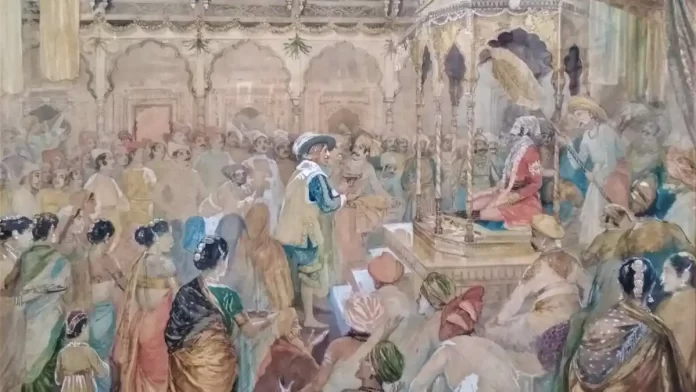In the annals of Indian history, Chhatrapati Shivaji, the founder of the Maratha Empire, stands tall as a visionary leader who defied Mughal dominance and laid the foundation for a powerful kingdom.
Beyond his military prowess, Shivaji’s genius extended to establishing a robust administrative system, with the Hazir Majlis taking center stage as the highest court of appeal.
This article delves into the fascinating world of Hazir Mazlis, exploring its structure, functions, and its lasting impact on Indian jurisprudence.
A Court With Deep Roots
The Hazir Majlis, literally translating to “Presence Assembly,” wasn’t an entirely new concept. It drew inspiration from existing judicial systems in Deccan India, particularly the Adalat system of the Bahmani Sultanate.
Shivaji, recognizing the importance of a well-defined legal framework, adapted and evolved these existing structures to suit the needs of his nascent empire.
Structure and Functioning
The Hazir Majlis sat at the apex of the Maratha judicial pyramid. It comprised a panel of judges, known as Adalkaris, chosen for their wisdom, legal expertise, and integrity.
While the exact number of Adalkaris varied over time, historical accounts suggest it typically ranged from four to eight.
Notably, these judges came from diverse backgrounds, encompassing Brahmins, Kayasthas, and even Marathas, reflecting Shivaji’s emphasis on merit and inclusivity.
The Hazir Majlis primarily served as a court of appeal, reviewing judgments delivered by lower courts within the Maratha territories. Litigants dissatisfied with lower court verdicts could petition the Hazir Majlis for a re-examination of their case.
The court meticulously scrutinized the lower court proceedings, ensuring adherence to established legal principles and customary laws.
Interestingly, the Hazir Mazlis wasn’t confined to civil matters; it also dealt with criminal offenses, including treason and rebellion.
Beyond Judgments: A Societal Impact
The Hazir Majlis transcended its judicial role by influencing social dynamics within the Maratha Empire. Shivaji, a devout Hindu, ensured the court upheld Dharma (righteousness) as a guiding principle.
However, he also recognized the diverse religious communities within his domain and encouraged the Adalkaris to consider customary laws and religious codes while delivering judgments. This fostered a sense of religious tolerance and inclusivity within the empire.
Moreover, the Hazir Majlis played a crucial role in curbing corruption and promoting efficient administration.
The Adalkaris were known for their incorruptibility, and strict penalties were in place for any attempt to influence their decisions. This instilled public trust in the judicial system and encouraged adherence to the law.
Also Read-
- Bal Gangadhar Tilak: Know his views on Nation, Caste & Women
- Malik Kafur and Delhi Sultanate: Rag to Riches Story of a Great Maratha
Distinct Features
Several unique features set the Hazir Majlis apart from other contemporary courts.
Firstly, the emphasis on oral arguments and deliberations fostered a dynamic and accessible legal system.
This contrasted with the heavily documented procedures common in other courts, making justice more readily available to the common people.
Secondly, the Hazir Majlis adopted a pragmatic approach to legal interpretations. While Dharma served as a guiding principle, the court also considered evolving social realities and local customs when delivering judgments.
This flexibility ensured that the law remained relevant and adaptable to the needs of the diverse communities within the empire.
Legacy and Enduring Influence
The Hazir Majlis remained a cornerstone of the Maratha judicial system for over two centuries, even after Shivaji’s passing.
Its principles of fair play, accessibility, and incorruptibility continue to resonate in modern Indian legal discourse.
The emphasis on religious tolerance and consideration of local customs laid the foundation for a pluralistic legal system that embraced diversity.
While the Hazir Majlis eventually gave way to evolving legal structures, its legacy lives on. Its commitment to justice,adaptability, and inclusivity serve as valuable lessons for contemporary legal systems in India and beyond.
The story of the Hazir Mazlis is not just about a court; it’s a testament to the enduring power of visionary leadership and its impact on shaping a just and equitable society.
Further Exploration
This article provides a glimpse into the fascinating world of the Hazir Majlis. If you’re interested in delving deeper, here are some resources:
- The Judicial Administration of Shivaji by V.A. Patil
- Shivaji and His Times by H.M. Moraes
- Maratha Administration by G.C. Wad
- A History of the Maratha People by R.S. Gupta
By exploring these resources and others, you can gain a richer understanding of this remarkable court and its lasting impact on Indian history and jurisprudence.
